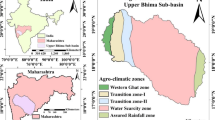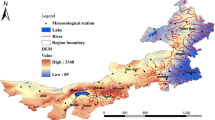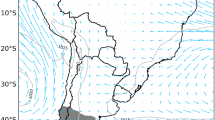Abstract
Grasslands in the Iberian Peninsula are valuable and susceptible ecosystems due to their location in arid-semiarid regions. Remote sensing techniques have potential for monitoring them through vegetation indices (VIs). The Modified Soil Adjusted Vegetation Index (MSAVI) is an improved version of classical VIs for arid and semiarid regions.
This work aims to analyse the relation among MSAVI, temperature (TMP) and precipitation (PCP) to understand the complexity of the vegetation-climate system. First, based on MSAVI pattern several phases through the year cycle are defined. Second, a cross-correlation between MSAVI and climatic variables series are performed for each phase at different lags to detect the highest correlation. Then, recurrence plots (RPs) and recurrence quantification analysis (RQA) are computed to characterize and quantify the underlying non-linear dynamics of the MSAVI series.
Our results suggest that five different phases can be defined, in this case study, in which TMP is the main driving factor. The correlation with TMP presents different signs depending on the phase. However, PCP plays a key role with a positive correlation regardless the phase. In the case of TMP, the correlations are higher and the lags shorter than PCP case. This explains the complexity of vegetation-climate dynamics.
RPs and RQA demonstrated to be a suitable tool to quantify this complexity. In our case, we have detected a high-dimensionality and a short-term predictability in the MSAVI series, characteristic of ecological systems.
Access this chapter
Tax calculation will be finalised at checkout
Purchases are for personal use only
Similar content being viewed by others
References
Rouse, J.W., Haas, R.H., Schell, J.A., Deering, D.W.: Monitoring the vernal advancement and retrogradation (green wave effect) of natural vegetation. Prog. Rep. RSC 1978–1, 2–8 (1973)
Huete, A., Didan, K., Miura, T., Rodriguez, E.P., Gao, X., Ferreira, L.G.: Overview of the radiometric and biophysical performance of the MODIS vegetation indices. Remote Sens. Environ. 83(1–2), 195–213 (2002)
Qi, J., Chehbouni, A., Huete, A.R., Kerr, Y.H., Sorooshian, S.: A modified soil adjusted vegetation index. Remote Sens. Environ. 48(2), 119–126 (1994)
Guo, B., Zhou, Y., Wang, S., Tao, H.: The relationship between normalized difference vegetation index (NDVI) and climate factors in the semiarid region: a case study in Yalu Tsangpo River basin of Qinghai-Tibet Plateau. J. Mt. Sci. 11(4), 926–940 (2014). https://doi.org/10.1007/s11629-013-2902-3
Shen, B., Fang, S., Li, G.: vegetation coverage changes and their response to meteorological variables from 2000 to 2009 in Naqu, Tibet, China. Can. J. Remote. Sens. 40(1), 67–74 (2014)
Eckmann, J.P., Oliffson Kamphorst, O., Ruelle, D.: Recurrence plots of dynamical systems. Epl 4(9), 973–977 (1987)
Li, S.C., Zhao, Z.Q., Liu, F.Y.: Identifying spatial pattern of NDVI series dynamics using recurrence quantification analysis. Eur. Phys. J. Spec. Top. 164(1), 127–139 (2008)
LP DAAC: Land processes distributed active archive center: surface reflectance 8-day L3 global 500 m, NASA and USGS (2014)
Baret, F., Guyot, G.: Potentials and limits of vegetation indices for LAI and APAR assessment. Remote Sens. Environ. 35(2–3), 161–173 (1991)
Xu, D., Guo, X.: A study of soil line simulation from landsat images in mixed grassland. Remote Sens. 5(9), 4533–4550 (2013)
Xu, M., Eckstein, Y.: Use of weighted least squares method in evaluation of the relationship between dispersivity and field scale. Groundwater 33(6), 905–908 (1995)
Webber, C.L., Zbilut, J.P.: Dynamical assessment of physiological systems and states using recurrence plot strategies. J. Appl. Physiol. 76(2), 965–973 (1994)
Coco, M.I., Dale, R.: Cross-recurrence quantification analysis of categorical and continuous time series: an R package. Front. Psychol. 5(1), 1–14 (2014)
Marwan, N.: CRP Toolbox 5.22 (R32.4) (2007). http://tocsy.pik-potsdam.de/CRPtoolbox/. Accessed 28 June 2019
Patro, S.G.K., Sahu, K.K.: Normalization: a preprocessing stage. Iarjset, pp. 20–22 (2015)
Webber, C.L., Zbilut, J.: Recurrence quantification analysis of nonlinear dynamical systems. In: Tutorials in contemporary nonlinear methods for the Behavioral Sciences Web Book, no. June, pp. 26–94 (2005). http://www.nsf.gov/sbe/bcs/pac/nmbs/nmbs.jsp. Accessed 5 June 2019
Wang, X., Ge, L., Li, X.: Pasture monitoring using SAR with COSMO-skymed, ENVISAT ASAR, and ALOS PALSAR in Otway, Australia. Remote Sens. 5(7), 3611–3636 (2013)
Heisler-White, J.L., Knapp, A.K., Kelly, E.F.: Increasing precipitation event size increases aboveground net primary productivity in a semi-arid grassland. Oecologia 158(1), 129–140 (2008)
Proulx, R., Parrott, L., Fahrig, L., Currie, D.J.: Long time-scale recurrences in ecology: detecting relationships between climate dynamics and biodiversity along a latitudinal gradient. In: Webber, C.L., Marwan, N. (eds.) Recurrence Quantification Analysis – Theory and Best Practices, no. February, pp. 335–347. Springer, Cham (2015)
Marwan, N., Kurths, J., Foerster, S.: Analysing spatially extended high-dimensional dynamics by recurrence plots. Phys. Lett. Sect. A Gen. At. Solid State Phys. 379(10–11), 894–900 (2015)
Belaire-Franch, J., Contreras, D., Tordera-Lledó, L.: Assessing nonlinear structures in real exchange rates using recurrence plot strategies. Phys. D Nonlinear Phenom. 171(4), 249–264 (2002)
Zhao, Z., Liu, J., Peng, J., Li, S., Wang, Y.: Nonlinear features and complexity patterns of vegetation dynamics in the transition zone of North China. Ecol. Indic. 49, 237–246 (2015)
Frilot II, C., Kim, P., Carrubba, S., McCarty, D., Chesson Jr., A.L., Marino, A.: Analysis of brain recurrence. In: Webber, C.L., Marwan, N. (eds.) Recurrence Quantification Analysis – Theory and Best Practices, no. February, pp. 213–251. Springer, Cham (2015)
Beckage, B., Gross, L.J., Kauffman, S.: The limits to prediction in ecological systems. Ecosphere 2(11), 1–12 (2011)
Marwan, N., Wessel, N., Meyerfeldt, U., Schirdewan, A., Kurths, J.: Recurrence-plot-based measures of complexity and their application to heart-rate-variability data. Phys. Rev. E - Stat. Physics, Plasmas, Fluids, Relat. Interdiscip. Top. 66(2), 1–8 (2002)
Acknowledgments
The authors acknowledge support from Project No. PGC2018-093854-B-I00 of the Spanish Ministerio de Ciencia Innovación y Universidades of Spain and the funding from the Comunidad de Madrid (Spain), Structural Funds 2014-2020 512 (ERDF and ESF), through project AGRISOST-CM S2018/BAA-4330 and the financial support from Boosting Agricultural Insurance based on Earth Observation data - BEACON project under agreement Nº 821964, funded under H2020_EU, DT-SPACE-01-EO-2018-2020.
Author information
Authors and Affiliations
Corresponding author
Editor information
Editors and Affiliations
Rights and permissions
Copyright information
© 2021 The Author(s), under exclusive license to Springer Nature Switzerland AG
About this paper
Cite this paper
Almeida-Ñauñay, A.F., Benito, R.M., Quemada, M., Losada, J.C., Tarquis, A.M. (2021). Complexity of the Vegetation-Climate System Through Data Analysis. In: Benito, R.M., Cherifi, C., Cherifi, H., Moro, E., Rocha, L.M., Sales-Pardo, M. (eds) Complex Networks & Their Applications IX. COMPLEX NETWORKS 2020 2020. Studies in Computational Intelligence, vol 943. Springer, Cham. https://doi.org/10.1007/978-3-030-65347-7_50
Download citation
DOI: https://doi.org/10.1007/978-3-030-65347-7_50
Published:
Publisher Name: Springer, Cham
Print ISBN: 978-3-030-65346-0
Online ISBN: 978-3-030-65347-7
eBook Packages: EngineeringEngineering (R0)




